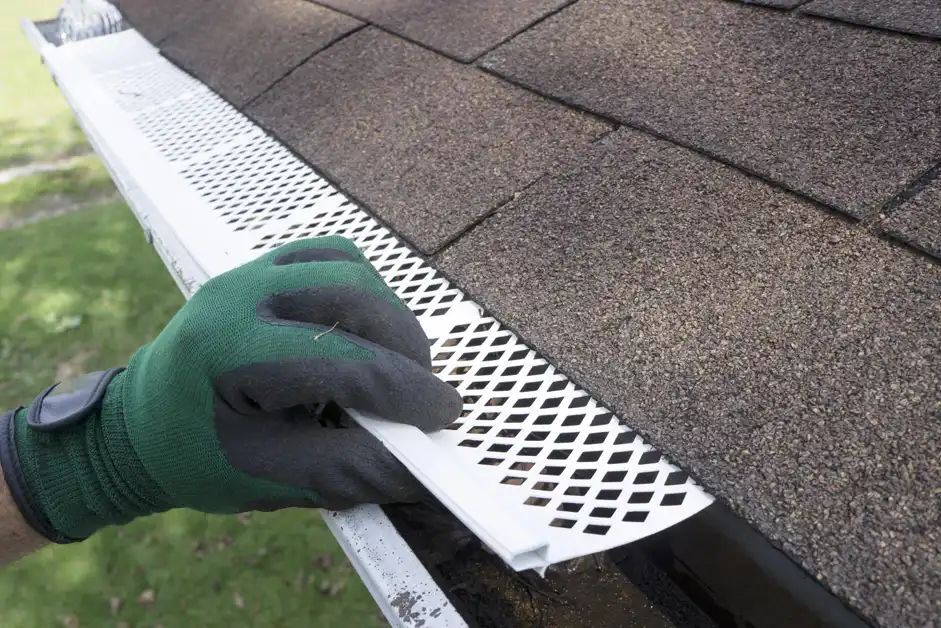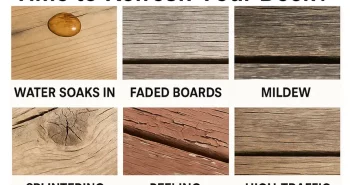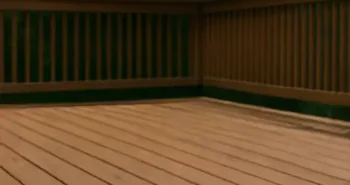Clogged gutters are no fun, and needing to get on your roof to clean them out can be downright dangerous. Fortunately, gutter guards are designed to keep debris out and help simplify home maintenance. To help you find the right system for your home, we’ll discuss everything you need to know about the various types of gutter guards available.
6 Main Types of Gutter Guard Systems You Can Use for Your Home
There are six types of gutter guards that homeowners can choose from, each of which offers unique advantages and disadvantages. Although it’s important to determine the type of gutter guard installation that best fits your home and geographic region, you can also talk to a home exterior professional for an expert opinion. The primary types of home gutter guard systems include the following.
1. Foam Gutter Guards
Foam guards are a unique type of protection system, and they’re one of the most affordable options for preventing clogged gutters. Essentially, they’re a piece of foam that sits inside the slotted opening of the gutter so debris can’t enter. Large and small debris will sit atop the foam while water drains through and runs inside the gutter. However, since the foam guards sit inside the gutter, debris can pile up, and water may start flowing down your roof instead of through the downspout.
Many homeowners who use gutter guards still need to clean out the gutters regularly. To do this, the entire piece of foam will need to be removed and replaced with a new one. As the guards are designed to be discarded and replaced, this can also lead to accumulating long-term maintenance costs.
Plus, when the foam is wet and stays wet for long periods, it can promote mold growth or even seedling sprouts. This, in turn, increases the risk of damage to your roof and drainage system and may even become a fire hazard. In areas with high sun, the foam tends to deteriorate more quickly.
2. Brush Gutter Guards
Brush gutter guards are an interesting type of leaf guard that essentially looks like a giant pipe cleaner. They’re placed in the gutter’s trough and help keep large debris from entering. However, the debris is trapped in brush guards, so they’ll need to be cleaned more often than other types. They can also deteriorate quickly under strong UV rays, so they will likely need to be replaced every few years.
Although initially, the ease of installation and low cost are attractive. Removing them for cleaning and reinstallation can be problematic. When debris gets stuck inside the bristles, it can be a big hassle as you’ll need to remove the entire system.
3. Reverse Curve Gutter Guards
Reverse curve gutter guards, also known as surface tension gutter guards, are one of the older types of systems. They use a hood with a curved edge and slight opening to help guide water into the gutter while various types of debris slide over and onto the ground.
Although it’s a great design, there are still some flaws. The biggest one is that the surface tension of the water flow decreases when the water flow is strong. So, in heavy rains, the water might just shoot off the edge of your roof instead of going into the drain. This can create issues with the foundation, as water won’t be directed away from your home. They also need to be installed underneath the shingles to get the proper pitch, which may cause issues with your roof’s warranty. If you’re interested in installing these guards, it’s important to see if your warranty will be affected. If it is, it’s probably best to choose a different option.
4. Screen Gutter Guards
Screen guards use perforated metal or plastic sheets to lay on top of your gutter system, effectively screening out debris and other materials. The holes are small enough so that medium to large debris can’t enter the gutter and disturb water flow. However, the holes aren’t small enough to keep things like pollen, pine needles, dirt, or shingle grit out. This can be problematic for homes in certain regions or homes with older asphalt roof shingles, as the debris can clog the drainage system. They’re also fairly lightweight, so they’re prone to blowing off gutters in high winds.
Installing screen gutter guards is simple. They can fit directly on your old gutters with no retrofitting necessary. Alternatively, you can choose professional installation if you prefer.
Although these are a great option for DIY gutter guards for your home, it’s important to determine if they’ll be effective in the long run. You may find that you still need to regularly clean your gutters, making them somewhat of a pointless expense. They are incredibly easy to install and relatively inexpensive. However, their lifespan is quite short, and you might have to do the same amount of gutter maintenance as you would without any gutter protection.
Mesh and micro-mesh gutter guards are types of screen gutter guards that provide more effective protection.
5. Mesh Gutter Guards
For something with more gutter protection, mesh guards may be a good alternative. These are screen gutter guards, but the holes are slightly smaller. This allows for more effective filtration and a stronger leaf protection system but may still allow debris like pine needles to pass through.
Due to the smaller size of the holes, leaves and other debris can’t enter the gutter. Therefore, you should rarely remove the guards for cleaning, as the water flow will remain strong. If you do feel like there may be a clog, it’s best to contact a professional for an inspection.
Mesh gutter guards come in several options, such as stainless steel and plastic. Metal options will be more durable and can protect your home for longer without replacing them. They can also be installed in different ways. To protect the integrity of your roof, it’s better to hire an experienced contractor for gutter installation. Thanks to effective gutter protection and design, mesh guards tend to be one of the more expensive gutter protection systems.
6. Micro-Mesh Gutter Guards
Micro-mesh guards have even smaller holes than mesh guards. This keeps even the smallest debris out of your gutter system, allowing water to flow freely all year. These are the best gutter guards available for homeowners living in areas heavily saturated with pollen, dirt, and pine needles. They drastically reduce gutter maintenance and are a great choice for your home regardless of location, but the price reflects their effectiveness. It should be noted that, due to the size of the micro mesh, the flow rate may be compromised during heavy rains or storms. Therefore, they’re best placed in low-flow areas around the roof to prevent water damage.
Stainless steel micro-mesh gutter guards require professional installation. Typically, during the process, the contractors will also recommend gutter cleaning and a thorough inspection before installing and sealing the guards to ensure that your drainage system is in good condition.
Which Gutter Guard Option is Best for You?
Not all gutter guards are created equal, but that doesn’t mean inexpensive options or those with a few drawbacks should be completely ignored. It really comes down to your location, budget, and preference for ongoing maintenance. Homeowners looking for new gutter covers can work with a professional to better understand which options are best for them. To help you handle all of your roofing and home exterior needs, get in touch with First Star Exteriors today.
At First Star Exteriors, we believe there’s a perfect balance between hands-on, personable treatment, quality of work, and speed of delivery. Our roofing contractors always take the time to understand your needs and communicate effectively from the first quote to the last nail placed. Whether it’s a roof replacement or installing gutter guards, we’re here to help with exterior home maintenance. To learn more about our services or to get a quote from us today within 48 hours, contact us at (479) 267-4800 or fill out our contact form here.





